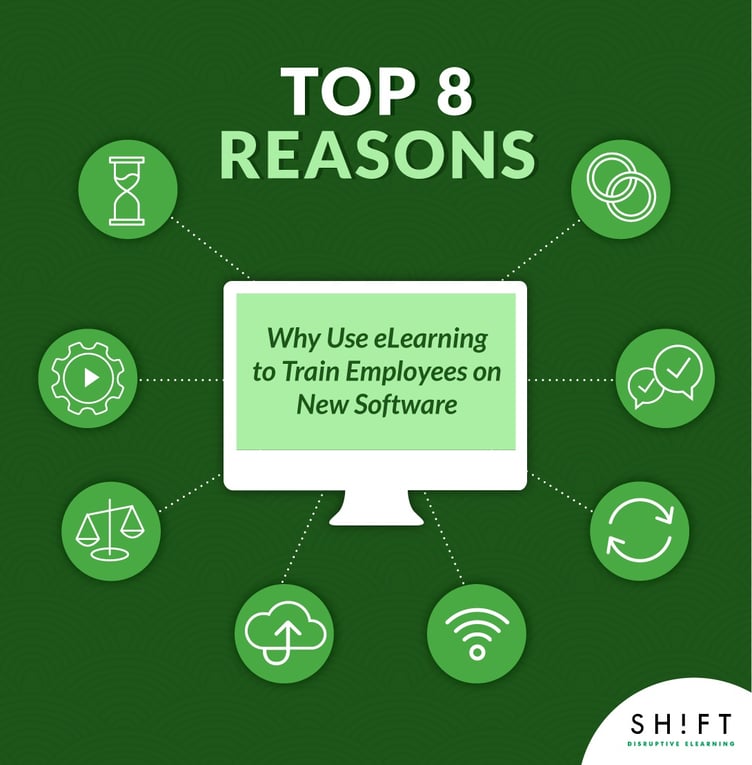You just got new software. It’s going to be great! It will increase productivity and communication and yield great results…IF everyone knows how to use it. But if they’re not well trained, you’ll never reap the benefits you paid for.
As the Training Manager, you’re responsible for training employees on the new tools and programs. It’s your job to make sure they know how to use its features, QUICKLY. Getting everyone in the company up-to-speed is your priority.
On top of that, it’s challenging to ensure everyone is adequately trained when new features are constantly added. The latest update always brings about changes to workflow and add new features to learn. To keep employees up-to-date, you need to employ the best training methods.
Investing in eLearning keeps your employees working at their peak efficiency. There was a reason you invested in that software - now give it a good chance to work by ensuring everyone can use it.
Use of online training and eLearning is increasing because it is effective.
According to Training Industry Report from 2015, one of the industry’s most trusted sources of data, eLearning often is used for desktop application training (70 percent vs. 56 percent last year) and IT/systems application training (67 percent, up from 54 percent last year)1.
Here’s why eLearning is the best option for training your staff on new software:

1) eLearning is Scalable
Scalability is important for any venture. But for successful software implementation - it’s vital.
The most scalable way to deliver training is with eLearning courses. eLearning is self-paced and available on-demand from anywhere. It can be taken by as many people as necessary, without any additional cost. That means the longer you use a course, the more cost-effective it is. The value grows instead of decreasing.
Using eLearning to roll-out new software allows organizations to push updates quickly to any number of people. You can quickly and easily keep your employees up to date and apprised of new features as they roll-out.
2) eLearning is Thorough
Don’t waste your money purchasing software your employees can’t fully use. Using eLearning for software training enables you to give a more comprehensive and in-depth learning experience to your employees.
Through interactive options, you can provide a close look at how functions work and how to use them. Don’t miss the chance to explain the capabilities, features and options people would never even know existed!
For instance, you can use:
- Step-by-step tutorials on features and capabilities
- Videos showing how to access key features
- Software simulations allowing users to practice their skills
- Practice exercises with practical, real-life cases
3) Faster Delivery Cycle Times
eLearning delivers instruction faster than classroom-based methods. By implementing an eLearning strategy in your company, your business’s training can be available all the time. Employees and interns are not stuck with a fixed schedule – they can learn when it works best for them. Their training is delivered on their schedule, at their pace, and in the best format for them to learn.
With traditional software training, you’re limited by space, instructor and cost constraints. eLearning removes those constraints by allowing you to train more employees in less time.
Read more: Facts and Stats That Reveal The Power Of eLearning [Infographic]
4) eLearning is Easy to Update
Software moves rapidly, and your training has to keep pace. Your training modules need to be kept up-to-date about the newest features.
Making changes to an eLearning course is fast and easy. You already have the training material. You just update the new features and roll it out again. Immediately, your employees will have access to the best training on the newest features.
Update the content, and it’s immediately available for everyone, everywhere.
5) eLearning is Accesible
eLearning methodology aligns with modern learners expectations. It is available on-demand, 24/7 for your employees.
When employees are struggling with software, they want to know where to look for answers. Using eLearning enables them to have one place to find those answers - quickly and easily.
eLearning supports users by giving users immediate access. Employees can solve their software issues quickly and in the moment of need (Just in Time). Having instant access to knowledge increases employee productivity and reduces downtime. It gives users one place for their software answers.
Moreover, one of the biggest benefits of eLearning is the training content is available whenever the employee needs it. That means your staff can go back and review functions and features when they need it. This also increases their efficiency and reduces their time spent searching for help.
Read more: Why Responsive eLearning is Essential to Meet Modern Learner Needs
6) eLearning is more Engaging
eLearning methodology aligns with modern learners expectations. It is available on-demand, 24/7 for your employees.
Let’s be honest; most people won’t read a 150-page user guide or a huge software manual. Modern workers want bite-sized information at the moment of need. They prefer searchable indexes with relevant training topics. They’d rather watch a video, animation or see screenshots explaining a process. eLearning delivers exactly what your employees need to stay up-to-date on software, in an interactive format they’ll appreciate.
By using the right eLearning authoring tool, your employees will learn from all of these interactive media:
- Screen shots detailing how to use a feature
- Videos showing how to access key features
- Audio explanation to cut down on reading
- Simulations for practical skills
Each of these tools leads to more interaction with your employees, which leads to better retention. Your employees are more likely to remember how to perform a key function if they’ve seen it performed than just reading about it.
7) eLearning is Stress-free
Learning to use new software is a complete ordeal for some people. Making it as easy and stress-free as possible for learners improved motivation, reduces frustration and leads to better training outcomes.
Through interactive exercises, users can practice how to use the new program without fear. This increases their confidence as they recognize they can use the software. Giving your employees a chance to test-drive the software makes for a stress-free roll-out.
8) eLearning Provides Consistency
Instructors aren’t always consistent. They vary in approach, direction and what they cover. They can get sick or make mistakes depending on their mood or a specific life circumstance.
On the contrary, eLearning provides consistent, standardized, reliable training - each and every time. One same eLearning course can train an entire global company. Every person can be reached with the same content, regardless of his or her location. This makes training reliably high quality and consistent.
eLearning is the answer for delivering reliable, high-quality training. It can be delivered anywhere, at any time. It’s easy to update and engages users with simulations, videos, and visuals.
REFERENCES:
2015 Training Industry Report https://trainingmag.com/trgmag-article/2o15-training-industry-report
Plan your end-user training strategy before software roll-out: http://www.techrepublic.com/article/plan-your-end-user-training-strategy-before-software-roll-out/
When Implementing New Software, Training Staff Properly Is Key to Success: https://www.workflowmax.com/blog/guest-post-when-implementing-new-software-training-staff-properly-is-key-to-success



